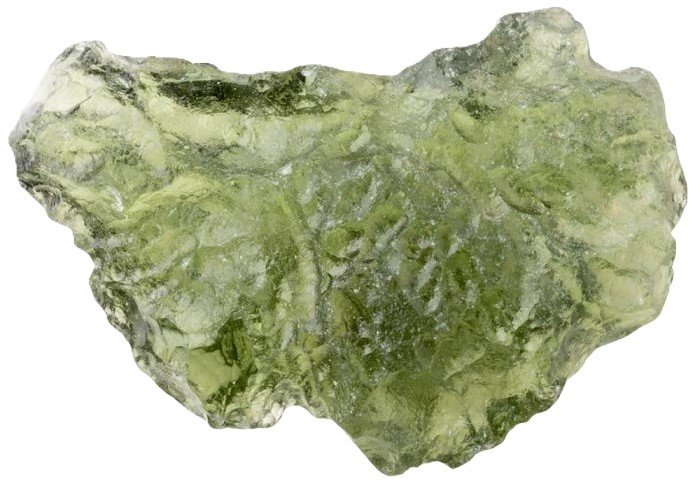
Moldavite derives its name from the River Moldau (Vltava) in the Czech Republic, where it was first discovered. The term was coined in the 19th century, based on its primary locality, and has since become widely recognised in both scientific and metaphysical communities.
Composition and Formation
Moldavite is a form of tektite, a naturally occurring glass formed from meteoric impacts. It primarily consists of silica (SiO2), aluminium oxide (Al2O3), and other trace elements. Its unique composition and formation process set it apart from other terrestrial minerals and gemstones. Its characteristic green colour, ranging from pale to deep forest green, is due to the presence of iron. Moldavite often has a rippled or bubbly surface texture and may contain lechatelierite, fused silica threads formed by the extreme heat of the impact
Moldavite is a tektite, a natural glass formed from terrestrial rock melted by the impact of a meteorite. Approximately 14.8 million years ago, a massive asteroid collided with Earth in the present-day Czech Republic, creating the Ries crater. The immense heat and pressure of this impact ejected molten rock into the atmosphere, which then cooled and solidified as it fell back to Earth, forming Moldavite.
Locations
Moldavite is predominantly found in the Czech Republic, particularly in the Bohemian and Moravian regions. Small deposits have also been reported in Austria and Germany. Due to its limited geographic distribution, genuine Moldavite is considered rare and highly valuable.
Physical Characteristics
Moldavite is typically green in colour, ranging from pale olive to deep forest green, with occasional brownish tints. It has a glassy, amorphous structure and often displays characteristic surface etchings, giving it a textured or sculpted appearance. Moldavite is relatively lightweight, with a Mohs hardness of approximately 5.5, making it more fragile than many traditional gemstones.
Archaeological Finds and Historical Usage
Moldavite has been discovered in prehistoric archaeological sites, where it was used as a tool and amulet by early human cultures. It has been linked to Neolithic artefacts, suggesting that it held spiritual or ritualistic significance. In more recent history, Moldavite has been set in jewellery and used in various decorative applications.
Current Usage
Today, Moldavite is highly sought after for its aesthetic appeal and metaphysical properties. It is widely used in jewellery, including pendants, rings, and earrings. Additionally, it is prized by collectors and spiritual practitioners who believe in its transformative and energetic qualities.
Interesting Facts
- Moldavite is the only known gem-quality tektite.
- Due to its meteoric origins, it is sometimes referred to as a “stone of the stars.”
- Moldavite’s unique textures are a result of natural etching processes over millions of years.
- Counterfeit Moldavite is common on the market, typically made of green glass, making authentication essential for buyers.
Folklore, Legends and Tales
Moldavite has been surrounded by mystical legends for centuries. Some traditions associate it with the Holy Grail, believing it to be a celestial stone that fell from the heavens. In Central European folklore, Moldavite was considered a talisman for good fortune and spiritual awakening. Many believe that it carries cosmic energies due to its extraterrestrial origins.
Astrology and Chakra System Links
In astrology, Moldavite is associated with transformation and enlightenment, often linked to the zodiac signs of Scorpio, Aquarius, and Gemini. It is considered a powerful stone for personal growth and spiritual evolution.
In the chakra system, Moldavite is believed to resonate strongly with the heart chakra, facilitating emotional healing and expansion. Some also associate it with the third eye and crown chakras, enhancing intuition and spiritual awareness. Many practitioners claim that Moldavite has an intense vibration, making it a catalyst for profound energetic shifts.tion and Formation
